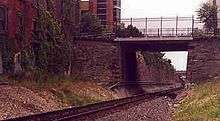Reading Railroad massacre
_(14781235923).jpg)
The Reading Railroad massacre of July 23, 1877, in which ten people lost their lives, was the tragic climax of local events in Reading, Pennsylvania during the Great Railroad Strike of 1877.
Set towards the end of the Long Depression of 1873–1879, the events of the massacre followed upon arson and riots against local facilities of the Philadelphia and Reading Railroad (commonly referred to as the Reading Railroad), units of the Pennsylvania State Militia (comparable to today's National Guard) were brought in by train. Near nightfall, one such unit was marched into the Seventh Street Cut, a man-made ravine, three blocks long with thirty-foot walls, to free a train that had been stopped there by rioters.

Bombarded from above with bricks, stones and possibly gunshots (accounts vary), some of the soldiers fired rifle volleys into a crowd at the far end of the Cut. Ten civilian deaths resulted from this gunfire. Most rioting ended that night, and tense quiet prevailed the next day. Ultimately, the arrival of federal troops restored order to Reading.
A coroner's inquest following the massacre did not blame the militia for the deaths, but pointed to the overall upheaval in the city at the time. Blame was also laid upon the local sheriff for failing to keep the public order.
See also
References
- Dacus, J.A. (1877). "Reckless Slaughter at Reading". Annals of the Great Strikes in the United States. Chicago: L.T. Palmer. pp. 205–222.
Further reading
- Explore PA History: Historical Markers, Reading Railroad Massacre
- "The Railroad Strike of 1877 in Reading"
- "Delineating A Fault: New Perspectives on the Reading Railroad Massacre"